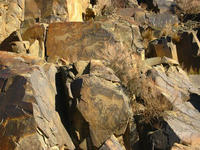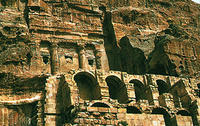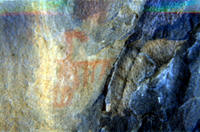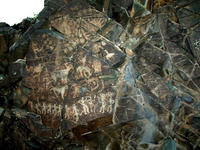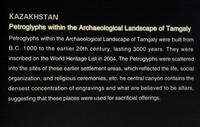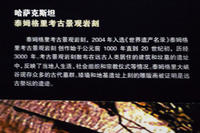You are in: Asia -> Kazakhstan -> Petroglyphs within t... , and traditional search or Image Gallery will yield results of this site only
Petroglyphs within the Archaeological Landscape of Tamgaly
| Site number: | 1145 |
|
| Type of site: | Cultural | |
| Date: | 2000BC-20th c. | |
| Date of Inscription: | 2004 | |
| Location: | Asia, Kazakhstan, Almaty Oblast | |
Up to 75 images are shown here. Click on each for more details or on Image Gallery for more images.
| Description: | Noteworthy concentrations of some 5,000 petroglyphs (rock carvings) sit around the fairly abundant Tamgaly Gorge, in the midst of the immense, arid Chu-Ili Mountains. The rock carvings date back to the late second millennium BC until the beginning of the 20th century. Demonstrating husbandry, social organization and rituals of pastoral peoples, they are dispersed amid 48 complexes with related settlements and burial grounds. Often the site’s human settlements are multi-layered and illustrate occupation through the ages. Moreover a vast amount of ancient burials are to be found here, including stone enclosures from the middle and late Bronze Age with boxes and cists, and stone and earth mounds, kurgans, constructed on top of tombs, a tradition from the early Iron Age to the present. The innermost canyon holds the densest concentration of engravings and supposed altars, symptomatic of these places being utilized for sacrificial offerings. --WHMNet paraphrase from the description at WHC Site, where additional information is available. For 360 degree imaging of this site, click here. | |
| Tamgaly is a petroglyph site in the Semirechye of Kazakhstan, some 20 km downstream from the Kapchagay Reservoir on the Ili River in the Anrakhai mountains. The name Tamgaly in Kazakh means painted or marked place. Tamgaly is located 170 km. to northwest of Almaty. The majority of the petrogylphs are in the main canyon, but there are a number in the many side canyons. The petrogylphs are mostly Bronze Age, but in some cases have been overlaid with Medieval or later etchings. Tamgaly became a UNESCO World Heritage Site in 2004. --Wikipedia. Text is available under the Creative Commons Attribution-ShareAlike License. For 360 degree imaging of this site, click here. | ||
| Source: | http://whc.unesco.org/en/list/1145 | |
| Reference: | 1. UNESCO World Heritage Center, Site Page. | |


